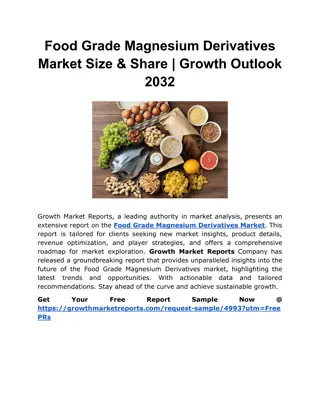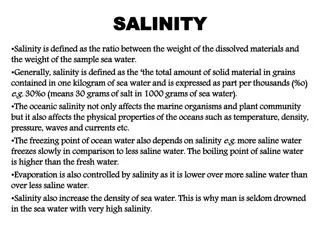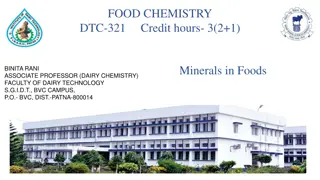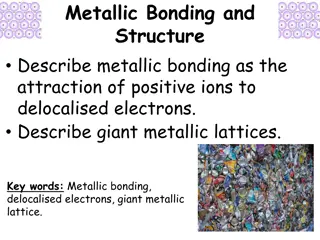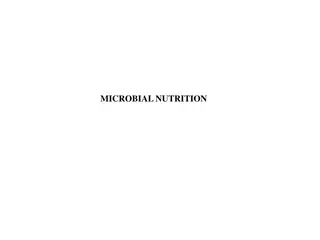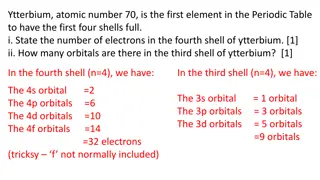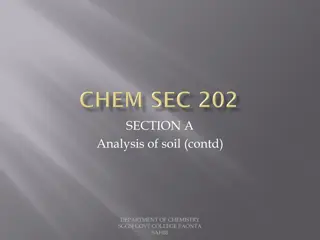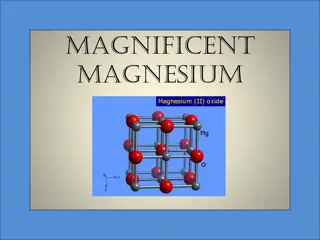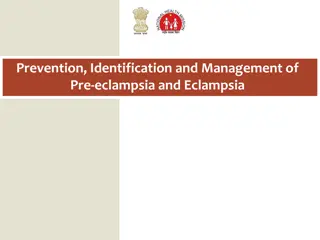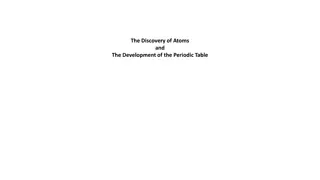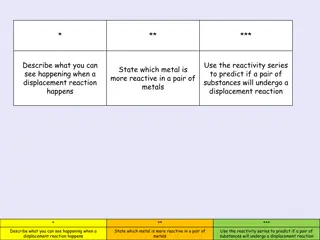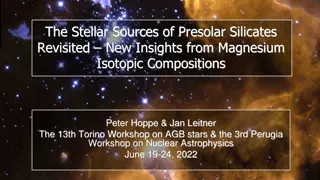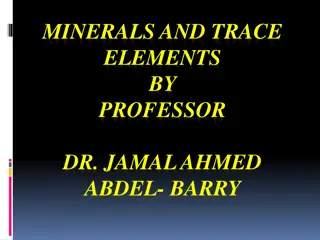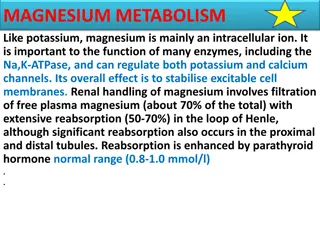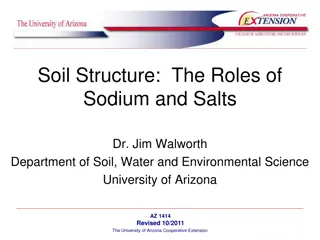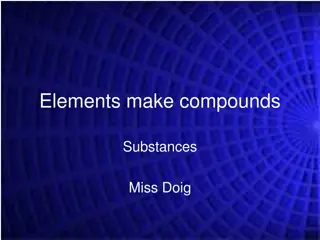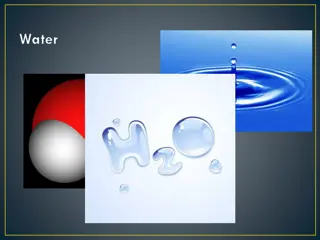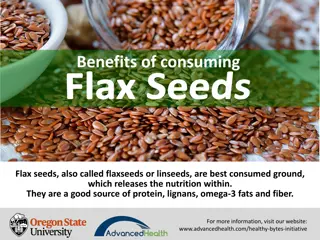Electrolyte and Metabolic Disturbances in the Critically Ill
Dr. Srilekha Ammapalli discusses the cations (sodium, potassium, calcium, magnesium) and anions (chloride, bicarbonate, phosphate, lactate) involved in electrolyte and metabolic disturbances in critically ill patients. The physiology, causes of abnormalities, diagnosis, evaluation, and management of
2 views • 104 slides
Organometallic Compounds of Group 2 Elements
In the realm of organometallic chemistry, Group 2 elements, specifically alkaline earth metals like beryllium and magnesium, exhibit intriguing properties and reactivities. The chemistry of these elements, mimicking that of Group 12 elements in many aspects, leads to the formation of various organom
5 views • 27 slides
Understanding Ionic and Covalent Bonding in Chemistry
Ionic bonding involves the transfer of electrons between a metal and a non-metal to form a giant lattice structure, like in sodium chloride and lithium oxide. Covalent bonding, on the other hand, occurs between non-metals, resulting in giant covalent structures or simple molecules. Examples such as
2 views • 79 slides
Permanent-Mold Die Casting Processes Overview
Permanent-mold die casting is a process where molten metal is injected into a mold cavity under high pressure, maintained during solidification. This process utilizes hot-chamber and cold-chamber die casting machines for casting various metals like zinc, aluminum, brass, and magnesium. Hot-chamber m
4 views • 7 slides
Elephant Toothpaste Experiment - Investigating Catalysts in Chemical Reactions
This extended experimental investigation explores the breakdown of hydrogen peroxide using different catalysts to create 'elephant toothpaste.' The experiment aims to determine which catalyst is most efficient at catalyzing the reaction, involving yeast, magnesium dioxide, and potatoes. Background r
0 views • 30 slides
Food Grade Magnesium Derivatives Market Size & Share | Growth Outlook 2032
The food grade magnesium derivatives market size was valued at around USD 876.3 Mn in 2022 and is estimated to reach USD 1443.1 Mn by 2031, expanding at a CAGR of 6.5% during the forecast period, 2023 \u2013 2031.
0 views • 5 slides
Magnesium Oxide Market Size, Worth, Overview, Scope & Analysis to 2022-2029
The Magnesium Oxide Market\u00a0research, a thorough examination of the state of the industry, market size, demand trends, development patterns, and projections from 2022 to 2029, was just published by Adroit Market Research.
0 views • 5 slides
Understanding Salinity in Seawater and Its Impacts
Salinity is the ratio of dissolved materials to the weight of seawater, affecting marine life and physical ocean properties like temperature, density, and waves. It influences freezing and boiling points, evaporation, and water density. Seawater composition includes salts like sodium chloride, magne
0 views • 11 slides
Understanding the Importance of Minerals in Foods
Minerals play vital roles in food chemistry and human nutrition. There are main elements, trace elements, and ultra-trace elements present in foods that contribute to various physiological functions. Sodium, potassium, magnesium, and calcium are essential minerals with specific roles impacting human
6 views • 27 slides
Understanding Metallic Bonding and Giant Metallic Lattices
Metallic bonding involves the attraction of positive metal ions to delocalized electrons, forming giant metallic lattices. In this structure, positive metal ions occupy fixed positions while electrons move freely throughout. This bonding is different from covalent bonding as it is delocalized, leadi
1 views • 19 slides
Chemistry Concepts: Valence Electrons, Ion Charges, and Ionic Compounds
Explore various key concepts in chemistry such as valence electrons in magnesium, Lewis Dot structure for silicon, charges on ions like strontium, formation of ions to achieve noble-gas electron configuration, elements forming ions with specific charges, and the octet rule. Learn about the character
1 views • 48 slides
Understanding Microbial Nutrition and Growth Factors
Microbes require carbon for metabolic activities, with organisms categorized as heterotrophs or autotrophs based on their carbon source. In addition to carbon, macronutrients like nitrogen, phosphorous, sulfur, potassium, and magnesium are crucial for cell function. Growth factors such as amino acid
0 views • 15 slides
Understanding Electron Configurations and Atom Properties
Explore topics including electron configuration, full shells, atomic numbers, and properties of elements like Ytterbium, Bromine, Mercury, Magnesium, and Europium. Learn about isotopes, ions, and orbital electron distribution in atoms like Europium and Nitrogen, as well as practice completing electr
1 views • 10 slides
Understanding Redox Reactions in Chemistry
Salts can be prepared through redox reactions involving metals and acids. This interactive lesson covers oxidation numbers, identifying oxidized and reduced elements, and explaining electron transfer in redox reactions. Examples include reactions of aluminum with sulfuric acid and magnesium with cop
2 views • 12 slides
Understanding Moles and Formula Mass in Chemistry
Dive into the world of moles, Avogadro's number, and formula mass calculations in chemistry. Learn how to convert moles to grams, grams to moles, and determine the number of atoms using Avogadro's number. Explore the concepts of formula mass and percentage composition to understand the composition o
0 views • 19 slides
Understanding Water Hardness and Impurities in Water Technology
Water technology in the field of Engineering Chemistry explores sources of water, major impurities, hardness of water, and distinctions between hard and soft water. The content delves into the impact of mineral concentrations on soap lathering, categorizes hardness into temporary and permanent forms
1 views • 72 slides
Understanding Direct Titration in Analyzing Soil Composition
Exploring the concept of direct titration in soil analysis, focusing on its role in determining the concentration of compounds such as calcium and magnesium ions. This method involves the direct reaction between the unknown compound and a known compound, without the need for excess reagents. Learn h
1 views • 34 slides
Understanding Bonding in Chemistry
Delve into the world of chemical bonding through ionic, covalent, and metallic bonds. Explore how elements form bonds, from the attraction between sodium and chloride ions to the sharing of electrons in covalent bonds. Witness the formation of compounds like sodium chloride and magnesium oxide, unde
1 views • 12 slides
The Importance of Magnesium for Good Health
Magnesium is a vital mineral essential for good health, with benefits including muscle and nerve function support, maintaining heart rhythm, and keeping bones strong. It is involved in over 300 bodily reactions and is abundant in the body, primarily in bones. Sources of magnesium include nuts, beans
0 views • 9 slides
Clinical Audit Results of Moderate to Acute Severe Asthma in EDs 2016/17
This clinical audit presentation showcases the national results of how Emergency Departments (EDs) are performing against the established audit standards for moderate to acute severe asthma in the year 2016/17. The objectives of the audit were to benchmark current performance, enable national and pe
1 views • 36 slides
Understanding Major Intra and Extracellular Electrolytes in Body Fluids
Body fluids contain various electrolytes crucial for maintaining cell and tissue environments. Electrolyte balance is essential for overall health, and external electrolyte replacement therapy may be necessary in certain conditions. The body's fluid compartments - intracellular, interstitial, and pl
0 views • 10 slides
Understanding Pre-eclampsia and Eclampsia: Prevention and Management
Learn about the prevention, identification, and management of pre-eclampsia and eclampsia, which are significant causes of maternal mortality globally. This session covers definitions of hypertensive disorders of pregnancy, supportive care for women with eclampsia, and the administration of injectio
1 views • 15 slides
Exploring Atoms, Elements, and the Periodic Table
Delve into the fascinating world of atoms and the periodic table with experiments on magnesium and zinc oxides. Discover how different elements combine to form compounds and analyze their composition. Learn about the relative atomic weights according to historical figures like John Dalton and Amadeo
0 views • 17 slides
Exploring Chemical Substances: Dissolved in Water
This article delves into the properties of various chemical substances when dissolved in water, including Calcium Carbonate, Sodium Carbonate, Iron Oxide, Magnesium Sulfate, and Potassium Chloride. It discusses the exothermic and endothermic reactions that occur during dissolution, along with the ch
0 views • 6 slides
Understanding Common Lab Values for Patient Care
Importance of referencing lab values regularly for patient safety and quality of care. Objectives include knowing normal ranges, interpreting values, and predicting treatment outcomes. Detailed information on common lab values like Sodium, Potassium, Magnesium, and their implications on patient heal
0 views • 22 slides
Understanding Displacement Reactions and Reactivity Series
Explore the concept of displacement reactions and reactivity series in chemistry. Learn how to predict if a pair of substances will undergo a displacement reaction and identify the more reactive metal in a pair. Observations and examples involving copper, magnesium, zinc, iron, and calcium are provi
0 views • 6 slides
Insights on Presolar Silicates and Magnesium Isotopes
Primitive meteorites contain presolar grains with unique isotopic compositions, paving the way for the study of stardust from stars to laboratories. Ion imaging techniques reveal the abundant presence of presolar silicates, showcasing advancements in in situ studies facilitated by cutting-edge techn
0 views • 17 slides
Overview of Minerals and Trace Elements in Human Nutrition
Minerals and trace elements play essential roles in the human body, categorized into groups based on their functions and requirements. Nutritional minerals like calcium, phosphorus, and magnesium are needed in larger amounts, while trace elements such as zinc and iron are required in smaller quantit
0 views • 50 slides
Understanding Magnesium Metabolism and Hypomagnesaemia
Magnesium, mainly an intracellular ion, plays a crucial role in enzyme function and cell membrane stability. Its renal handling involves filtration and reabsorption, with hypomagnesaemia often linked to hypocalcaemia. Causes include inadequate intake, excessive losses from GI and urinary sources, an
0 views • 17 slides
Understanding Chemical Reaction Factors
Explore the impact of temperature, concentration, catalysts, and surface area on the rate of chemical reactions. Learn how these factors influence reaction speed through real-life applications and experiments such as Alka-Seltzer in water and magnesium ribbon with different HCl concentrations.
0 views • 19 slides
Understanding the Biochemistry of Insect Hemolymph
Insect hemolymph, also known as blood, plays a crucial role in maintaining the tissues throughout the body. It consists of plasma containing hemocytes suspended in a fluid rich in various chemicals. The pH of the hemolymph ranges between 6.4 and 6.8, with variations in volume across different insect
0 views • 9 slides
Practical Guide to Pharmaceutics Experiments by Mr. Nilesh A. Shinde
This practical guide covers Experiment No. 9 on preparing Magnesium Hydroxide Mixture, including ingredients, procedure, and the definition of pharmaceutical mixtures in pharmaceutics. It provides detailed steps for creating the mixture, along with the characteristics and storage instructions for Ca
0 views • 8 slides
Understanding the Role of Sodium and Salts in Soil Structure
Soil structure plays a crucial role in plant growth, water movement, and drainage. Excess sodium can cause clay particles to disperse, leading to reduced water infiltration. Flocculation, which involves cations like calcium and magnesium, helps clay particles stick together to form aggregates, impro
0 views • 29 slides
Understanding Compounds and Elements through Experiments
Explore the world of compounds and elements through engaging experiments involving magnesium, oxygen, and more. Learn about the energy released when elements combine, naming conventions for various compounds, and the significance of oxygen in compound naming. Discover essential elements and their sy
0 views • 10 slides
Understanding Chemical Formulas and Subscripts in Chemistry
Chemical formulas and subscripts are fundamental concepts in chemistry for expressing the composition of substances at the molecular level. This article explores the significance of chemical formulas in representing elements and compounds like water (H2O), carbon dioxide (CO2), sodium chloride (NaCl
0 views • 37 slides
Chemistry Revision: Atomic Structure and the Periodic Table - AQA Trilogy
Explore key concepts in Chemistry Revision for AQA Trilogy including atomic structure, periodic table organization, separation techniques, symbol equations, electron structures, isotopes, and more. Learn about burning magnesium, crystallization, chromatography, fractional distillation, and propertie
0 views • 10 slides
Overview of Thermostable DNA Polymerases and Their Properties
Thermostable DNA polymerases play a crucial role in various molecular biology techniques, with Taq DNA polymerase being a household name due to its discovery in Thermus aquaticus. These enzymes catalyze DNA synthesis, require magnesium ions for activity, and exhibit optimal function at high temperat
0 views • 8 slides
Techniques for Separating Mixtures: A GCSE Guide
Explore various separating techniques such as chromatography, distillation, filtration, and crystallization for different mixtures in a GCSE science context. Learn how to separate substances like solutes, solvents, liquids with similar boiling points, magnesium, salt, and more. Engage in a challengi
0 views • 5 slides
Unveiling the Health Benefits of Flax Seeds
Flax seeds, a nutritional powerhouse, offer a myriad of health benefits such as being a rich source of protein, omega-3 fats, lignans, and fiber. Consuming ground flaxseeds can aid in managing cholesterol levels, improving heart health, reducing the risk of cancer, osteoporosis, and promoting weight
0 views • 7 slides
Entomophagy and the Nutritional Benefits of Eating Grasshoppers
The International Conference on Food Technology delved into the practice of entomophagy, focusing on the consumption of grasshoppers. With over 80 edible species of grasshoppers globally, they provide essential nutrients such as proteins, fats, vitamins, and minerals. Grasshoppers are known for thei
0 views • 11 slides





